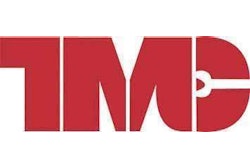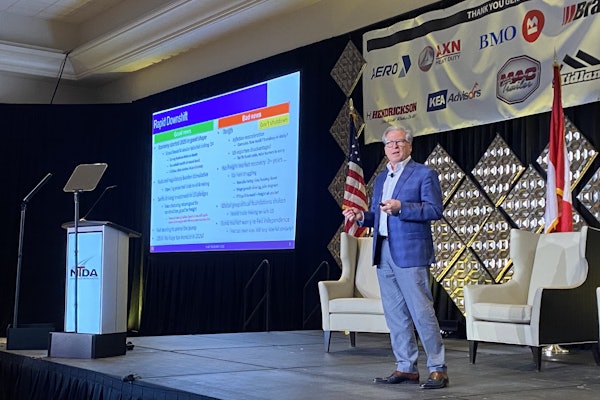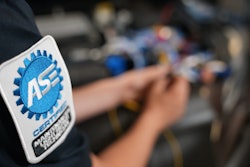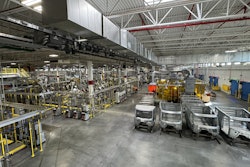
According to an August 2021 industry report from FTR Transportation Intelligence, active truck utilization has held firm at 99 percent or better throughout 2021 and is anticipated to remain above 95 through 2022. For an industry that averaged 91 percent utilization in the decade prior, those numbers are eye-popping.
Extreme utilization rates can have positive and negative impacts for truck dealer and aftermarket operations.
On one hand, when every truck is actively in use that means every truck is a candidate to require parts, service or maintenance. Sales opportunities are maximized. On the other hand, when every truck is actively in use and any require downtime, truck owners also are don’t have excess units available to replace a sidelined truck in the field. Which means downtime, now more than ever, absolutely must be kept to a minimum.
For those in the service space, this is undoubtedly a challenge, but it’s also an opportunity. The pressure dealer and aftermarket service technicians face to diagnose and fix trucks quickly and effectively can’t be eliminated, but by offering thorough preventive maintenance (PM) programs, service providers can reduce the likelihood a customer experiences unplanned downtime and is strained by lengthy repair at the worst possible time.
Below are six tips from industry experts on how service shops can successfully sell PM programs in the field.
Identify the best candidates
Not every customer is a fit for outside PM programs. Many medium and large fleets develop their own PM programs, while owner-operators with one or two trucks may do their own maintenance or already rely on your shop for scheduled service events.
Fullbay, which recently developed a comprehensive white paper offering guidance for service providers who want to sell preventive maintenance, says the best candidates for outside PM programs are generally small- to medium-sized fleets that have enough trucks to provide steady PM work but might not have their own service facility or enough technicians to perform all maintenance in house. Fleet Advantage’s Matt Wiedmeyer adds a good candidate for a comprehensive maintenance program is a customer who knows it needs to reduce its downtime and service costs but can’t do it alone.
Do your research
While a potential candidate for outside PMs does not have to be an existing customer, it can be challenging to develop a strong pitch for a business with whom you don’t currently have a relationship. Fullbay COO Chris O’Brien a good way to identify potential candidates for PM work is to evaluate your own internal sales and service data. Customers purchasing wear parts at higher-than-normal intervals may be good candidates, as will customers who experience large numbers of emergency service events. O’Brien says Fullbay advises service providers to develop pitches that clearly show customers how much money they are losing without a strong PM program.
“If you have a deep relationship [with the customer], you should get a shot at the table,” he says.
Be direct
If a customer accepts a meeting to discuss PMs, make it worth their time. Show them your financial projections and how much money they can save. Offer examples of other customers you’ve onboarded and their savings (if applicable). List the services your business offers and the tactics you would use if the customer accepted your services. Fullbay notes that while there are services that should be offered under any PM package, no two fleets are alike. A good PM pitch should be customizable to the needs of the carrier in question.
[RELATED: On-site fleet maintenance offers benefits for service providers and their customers]
“Your job here is to ask questions, listen to their answers, and sort out what’s really going on with their vehicles,” Fullbay writes in its white paper.
Do your research. Again.
An initial PM discussion doesn’t need to end in a handshake deal to be a win. O’Brien says if a customer listens to a pitch and is willing to consider future action that’s a good sign. He says in those cases, Fullbay advises service providers to ask customers for their more detailed service records. He says this request can enable a service provider to do more in-depth fleet analysis and return to the customer with the best possible PM package.
Wiedmeyer agrees, adding the more information a service provider can acquire, the better their proposal will be. “Fleets have so much data today that can be leveraged and used to reduce their downtime,” he says.
Make your case
Follow-up meetings with prospective customers need to include decision makers. This means not only directors of maintenance, but also controllers and executive staff. A PM contract is a large investment for most fleets, O’Brien says. Service providers shouldn’t risk making their case to someone who is not a decision maker and could potentially alter their message before it reaches its intended target. “You want to know who the stakeholders are,” he says.
The final conversation also should include address how customers would be served for non-PM work. O’Brien says this is extremely important — a PM program shouldn’t give a customer carte blanche to always demand shop prioritization. He adds, “If you build your shop around a customer, you’re basically beholden to them.”
Follow through
Once a deal is signed is when the real works begins. Vehicle owners commit to PM programs to save money and maximize uptime. A good partnership can sour fast if a service shop fails to deliver on what it promised. It's best if service shops assign experienced, reliable, self-motivated technicians to PM programs since they are likely to work in isolation. Wiedmeyer also advises service providers use the data collected in their fleet analysis to stock up on a customer’s high-volume parts so technicians never face delays waiting for components.
Downtime costs truck owners $800 to $1,200 per day. If you’ve sold a customer on a PM program, experts say it is your job to minimize those losses as much as possible. “A good PM partnership should be a win-win relationship,” O’Brien says.











